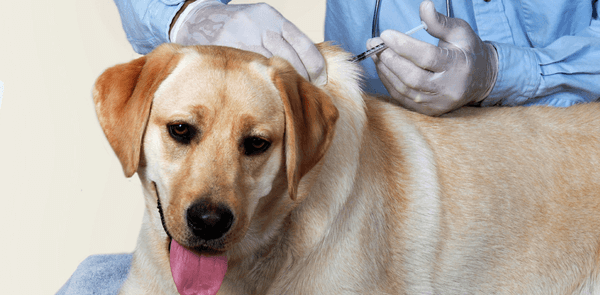
It’s every dog owner’s worst nightmare – rabies.
Every mammal is susceptible to rabies, and it is fatal. Tens of thousands of people die every year worldwide from this deadly disease. Only 6 people have ever survived the full-blown virus; those 6 only survived due to a groundbreaking new treatment.
NOTE: Everyone is required BY LAW to have a licensed veterinarian administer the rabies vaccination and booster shots to your pets and livestock on a regular schedule. Contact your family’s veterinarian for more information.
Friday, September 28th is World Rabies Day, a day set aside to increase community awareness and spread information on how to prevent the disease. The theme this year is Rabies: Share the message. Save a life.

Here are 15 things you should know about rabies, including what symptoms to look for, how you can be prepared, and what you need to know about the vaccine’s adverse reactions so you can make informed decisions about your dog’s health.
-
What is rabies?
Rabies is a viral disease that affects the central nervous system of a mammal.
-
How is rabies transmitted?
Transmission occurs primarily when a rabid animal bites another mammal. Although rare, transmission of the disease has been known to occur through infected saliva having contact with a break in the skin.
-
What happens in the body once a person or animal is infected?
After the rabies virus enters the body, it begins to multiple near the point of entry. If the infection is not stopped at this point, it will spread to the nerve tissues and then to the brain, where it multiplies. The virus will then spread throughout the nervous system of the body, from the brain to the salivary glands and other parts of the body.

-
How common is rabies?
Rabies is not as rare as you might think. According to the Centers for Disease Control and Prevention (CDC), it exists in every continent except Antarctica. While we don’t have exact numbers due to poor reporting in Asian and African countries, it is estimated there are 55,000 human deaths from rabies every year globally.
In the U.S., the number of rabies is relatively low. On average, there are only two or three cases of human rabies and about 5,000 – 6,000 cases in animals each year.
-
Is there a cure for humans if they are exposed to the rabies virus?
Rabies biologicals for human are 100 percent effective if administered quickly and properly. On average, 30,000 – 60,000 people are exposed each year and receive this prevention treatment, which is called Post Exposure Prophylaxis (PEP).
-
Is there a cure for dogs if they are bit by a rabid animal?
Unfortunately, there is no cure for an animal if they are infected. The only remedy is to prevent infection by having regular vaccines.

-
What are the symptoms of rabies in dogs?
A person or animal that contracts rabies will either act hyperactive (furious rabies) or weak and with a loss of coordination (paralytic rabies.)
Symptoms of rabies in dogs include:
- Pica (eating dirt, rocks or other non-food items)
- Fever
- Seizures
- Paralysis
- Hydrophobia (afraid of water)
- Jaw drops open
- Inability to swallow
- Excessive salivation
- Frothing or foaming at the mouth
- Change in tone of bark
- Muscular lack of coordination
- Unusual shyness or aggression
- Excessive excitability
- Constantly irritable – noticeable change in attitude and mood
- Paralysis in the mandible and larynx
-
What should I do if I suspect my dog has been exposed to rabies?
If your dog has been bitten by a wild animal or bites a person, a current proof of vaccination is required. If you don’t have proof of current rabies vaccination, 6 months of quarantine at the owner’s expense or euthanasia is required by law.
-
Can my veterinarian test my dog to see if he or she has been infected?
There is no effective test for rabies that works on a living animal. A sample of the brain is required to prove the virus is present. Rabies tests for animals are only given post mortem. For humans, the gold standard is a fluorescent antibody test that can be administered through brain tissue or cerebrospinal fluid. There are a couple of other tests available as well, such as molecular-based, negri-body detection or serological.
-
What is the incubation period for rabies?
Rabies incubation periods can range from days to years. However, the average incubation period is 3 to 8 weeks.

-
How soon after being infected will an animal be infectious?
An animal is infectious as soon as the virus spreads from the entry site to the salivary glands. Most animals will be infectious in 3 to 6 days after exposure and will generally not live more than a few days following that. If an animal is healthy 10 days after a biting incident, it is safe to assume that were not infected.
-
How can I protect myself from rabies?
People are more likely to be infected by pets than wildlife. For this reason, immunization is important for yourself as well as your dog. In addition to vaccinating your pets, here are other ways to protect yourself and your family:
- Don’t approach animals you don’t know
- Don’t handle bats
- Don’t feed wildlife
- Don’t handle sick, injured or dead animals
- Teach children how to properly interact with animals (don’t tease the animal, pull its tail or ears, lunge at the animal, take its food, etc.)
-
How can I protect my dog from getting infected?
- Make sure your pets have current rabies shots
- Keep pets in a fenced yard or on a leash when outside the home or yard

-
What is the controversy surrounding rabies’ vaccinations?
A very, very small number of dogs have shown an adverse reaction to the rabies vaccination. In a 3-year period, 120 million vaccination were administered and, out of that number, 246 dogs had a negative reaction.
Negative reactions to the vaccine include: fever, sluggishness, loss of appetite, facial swelling or hives, vomiting, diarrhea, pain at the injection site, lameness, collapse, difficulty breathing or seizures.
If your dog shows any of these signs, contact your veterinarian. Rabies vaccination waivers are permitted in Colorado on a case-by-case basis with justification.
-
What should I do if my dog is bitten by an animal or bites a person?
You are required BY LAW to report animal bites or exposures, especially bat-human or bat-animal interactions.
Contact the El Paso Public Health Department at 719-579-3119. Click here to visit the El Paso County Report an Animal Bite webpage.

Rabies is a preventable disease. The vast majority of rabies cases in Colorado are reported in raccoons, skunks, bats and foxes. To learn more, click here for the CDC Rabies website.
The Global Alliance for Rabies Control is working towards eliminating this horrible disease in dogs by the year 2030. We hope you will join us in supporting this coordinated effort to prevent cases of rabies in the future.
Having a current rabies vaccination is a requirement for all dogs attending Canine Campus. Let us know if you have any questions.
Have you experienced a dog with rabies? What was your experience? Please share with us in the comments below.
It’s not to early to start thinking about overnight stays for the holidays. We tend to book up fast so don’t hesitate to contact us if you’re thinking of traveling or just need a place for your pooch during the busy holiday season. Call us at 719-448-9600 to discuss your needs – we’d love to hear from you!
—————-
Source:
“Rabies.” Centers for Disease Control and Prevention, Centers for Disease Control and Prevention, 23 Aug. 2017, www.cdc.gov/rabies/location/usa/surveillance/human_rabies.html.













Leave a Reply